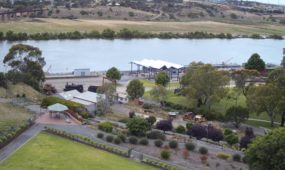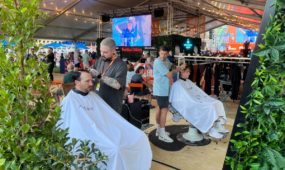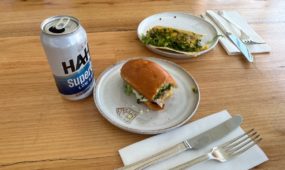Sanctuary bid to save dolphins Down Under
Tourism
AN AQUATIC resort could help save a wild dolphin colony that has become reliant on human food handouts off the coast of South Australia.

Sign up to receive notifications about new stories in this category.
Thank you for subscribing to story notifications.
A study by dolphin experts found the building of a resort-style sanctuary for the dolphins would not only help ensure their survival but become a major international tourist attraction.
Marine mammal researchers say the dolphins off the coast of Whyalla, almost 400km northwest of the South Australian capital Adelaide, are given an average of 700g of fish per day, making them increasingly dependent on human handouts.
Founder of not-for-profit organization Australian Institute of Marine Rescues and one of the 2015 study’s authors Troy Saville said he wanted to help manage the feeding of the Whyalla dolphins by building a marine mammal interactive centre and sanctuary.
“Although there are laws prohibiting people from feeding dolphins, it was clear to us that this wouldn’t change,” he said.
“At the moment they are just getting fed whatever people give them. Our suggestion is to control the feeding and reduce their intake to 10 per cent of what they normally get.
“That way we can encourage them to come feed for a little bit and then go out and spend time with their young, hunt for fish themselves, and display normal dolphin behaviour.”
Port Adelaide is already home to a dolphin sanctuary, which attracts more than 100,000 visitors a year and is one of the only places in the world wild dolphins can be observed in their natural habitat near a major city.
Whyalla is an industrial town at the top of Spencer Gulf with a population of about 20,000. It is desperately looking for ways to grow its economy following the uncertainty surrounding the local steel mill – one of the region’s major employers.
Whyalla is also well known as a breeding ground for the mysterious Giant Australian Cuttlefish, which are a food source for the dolphins.
Saville said an interactive centre in Whyalla similar to the Tangalooma Island Resort in Eastern Australia could help regulate the dolphins’ diet, help save the population and create jobs.
The proposal is being considered by Whyalla City Council.
“The change in dolphin diet and regular dolphin behaviour could have serious consequences for the local population,” Saville said.
“You need to have control over the quality of fish that these animals are being fed and feeding them at a specific time so that they are not staying in the one area looking for these handouts.
“It was our conclusion that there probably needed to be some protection around the animals and we put forward a proposal to the council last year.”
The Tangalooma Island resort was established on Queensland’s Moreton Island in 1980 and has become one of the world’s premier destinations for human interactive activities with marine wildlife.
Every evening selected guests are allowed to wade in the water and feed the wild dolphins under professional supervision.
The resort has become a billion dollar business and attracts tens of thousands of international visitors every year.
In the 1990s Moreton Island experienced a similar population crisis where dolphins became highly dependent on human handouts. During winter a number of them died because they weren’t fed by humans as often and had lost their will to hunt for their own food.
The resort on Moreton island has since served as a dolphin sanctuary.
“I helped set up Tangalooma in the ’90s … I think that we can draw a similar international interest here,” Saville said.
“Our main objective is to protect the animals and make sure that the dolphins have a better life, but there’s an opportunity to see the effect of human interaction on the animals as well.”
“By controlling the feeding you can have a spin off where it becomes a tourist attraction as well.”
Jump to next article



